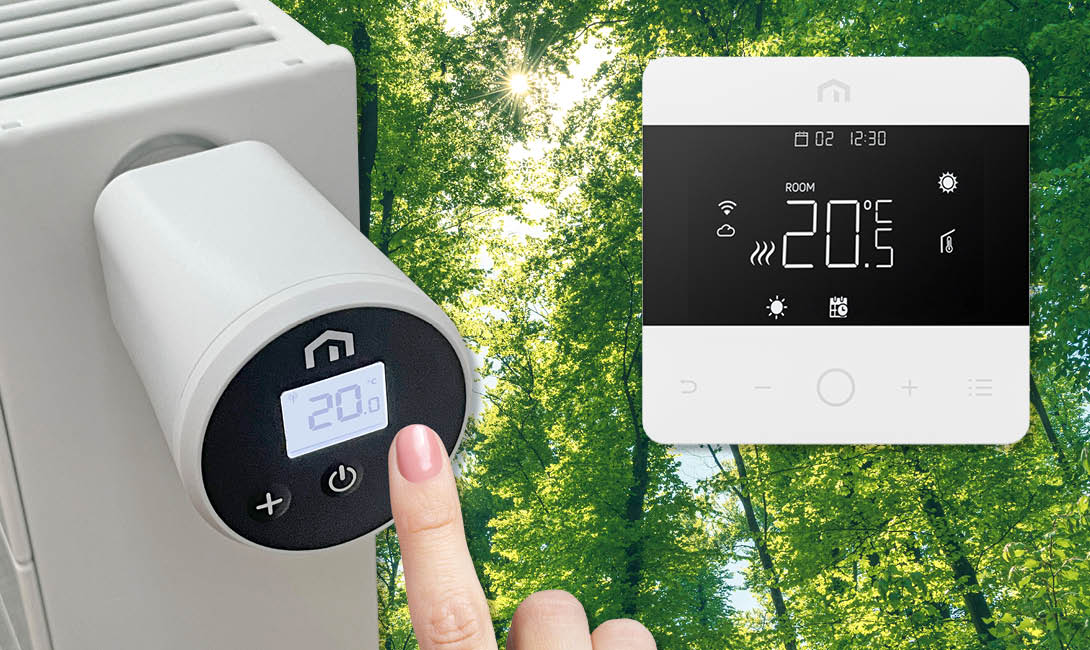- Improve efficiency
- Energy saving
- Hydronic heating
- Product info
How heating controls help to lower the cost of comfort
Saving energy with heating controls
A key step towards decarbonising home heating is to better insulate existing buildings. This helps to save energy as well as reduce the amount of fossil fuels used for heating and cooling. However, to reach our ambitious climate targets, thermal retrofitting should be complemented by a review of the central heating system to ensure that an efficient heating system is working inside an efficient building. If the budget allows, this can mean switching to a heat pump fuelled by renewable energy, combined with low temperature radiators, fan convectors or underfloor heating.
Learn more about low temperature radiators for heat pumps
However, budgetary or practical restraints may make it impossible to upgrade the entire system at once. Luckily, small changes in the use of the heating controls can already make a significant difference in the reduction of both fuel consumption and carbon emissions. After all, more control allows for better tailoring of the system so that you only use the exact amount of energy you actually need to enjoy indoor climate comfort all year round.
Modern hydronic and electronic heating controls
Despite the fact that both hydronic and electronic heating controls continue to improve in terms of accuracy and user comfort, practice shows that many people still don’t really understand and use their controls properly. This is unfortunate as it means they are missing out on comfort as well as energy savings.
Basic heating controls for a central heating system include at least a programmer (timeclock), a room thermostat and, in case of a radiator system, thermostatic radiator valves. The right use of these core elements can already get you on track to effective and efficient energy use. Adding modern heating controls, or even smart heating controls such as our Unisenza Plus range, moreover makes it easier than ever before to upgrade existing systems and further optimise both fuel consumption and the heating system’s carbon footprint.
Potential energy savings with heating controls
Two types of heating controls hold the key to preventing the temperature from rising unnecessarily: the room thermostat and the thermostatic radiator valves. This is endorsed by recent test results1 published by BEAMA, the UK trade association for manufacturers and providers of energy infrastructure technologies and systems. They calculated the potential savings on fuel bills through the application of a number of heating controls. Their baseline situation is a timeclock, Class I on/off room thermostat and manual radiator valves. The tests show that by simply adding thermostatic radiator valves (TRVs), homeowners can already save an average of 18% on their fuel bills. Upgrading the Class I room thermostat to a Class IV device with load compensation or Class V/VI with load/weather compensation results in an additional average saving of 10 and 12%, respectively.
Read more about the added value of thermostatic radiator valves in energy saving
In their report BEAMA also includes results for savings from smart controls based on a study by the Behavioural Insights Team. These results indicate that by upgrading a basic programmer to one with smart control, there is a cost savings potential of 6%. When the smart controls are combined with the other studied elements to do a full upgrade, the average estimated savings further increase to 31% with a Class IV room thermostat and 32% with a Class V or VI room thermostat. A great indication of how heating controls can help to lower the cost of comfort without renovating the entire heating system at once.
Potential CO2 savings with heating controls
While savings on the fuel bills can obviously make a difference to many people, the bigger goal is to reduce our carbon footprint. A renovation of the heating system has great potential in that area as well. In line with costs savings, we see that heat generation and distribution represent nice opportunities in terms of CO2 savings as well. And again, heating controls play a significant role.
A study by the ITG Dresden2 shows that replacing the heat generator in an existing heating system can save an average of 2.7 t/a of CO2. If the system is further optimised and the flow temperature is reduced to 35°C, for example, a further 0.46 t/a can be saved. An additional CO2 savings potential of 0.29 t/a is offered by the heating controls. That is the equivalent of driving 1740 km with a diesel car or 20 trips from Amsterdam to Paris with the Thalys. An important contribution from controls alone, which again highlights the role they can play in actively reducing fuel consumption as well as carbon emissions.
Discover our complete range of heating controls
Sources:
1. https://www.beama.org.uk/resourceLibrary/winter-2022-23-fuel-bills-savings-using-heating-controls.html
2. https://www.bdh-industrie.de/fileadmin/user_upload/Positionspapiere/Positionspapier_Niedrigtemperaturwaermeuebergabe_052021.pdf.pdf

